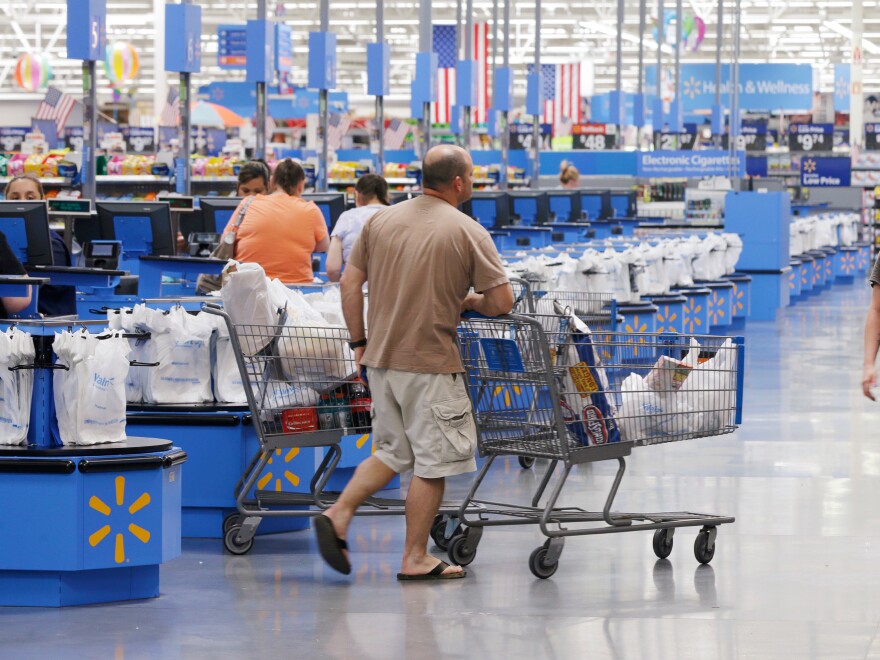Earlier this month, Wal-Mart trumpeted that it had beaten a goal it set five years ago: to open at least 275 stores in food deserts by 2016. That targeted expansion into "neighborhoods without access to fresh affordable groceries" came as part of the retailer's "healthier food initiative," lauded by — and launched with — First Lady Michelle Obama in 2011. Wal-Marts have been popping up in lower-income urban areas where grocery stores are scarce ever since.
But new research suggests that plugging food access holes with big box stores may not lead to healthier habits. According to a study just published online in the American Journal of Preventive Medicine, Americans' junk food calories increasingly come from big box stores rather than traditional grocers.
The share of calories from packaged food products purchased at mass merchandisers, convenience stores and warehouse clubs nearly doubled from 2000 to 2012, rising from 23 percent to 40 percent, according to an analysis of Nielsen Homescan data by University of North Carolina researchers. That increase was almost entirely driven by a loss in packaged food sales at grocery stores, whose share of those sales dropped from 69 to 51 percent over the same period. ("Packaged food products" here means processed and shelf-stable foods, including snacks, soda and desserts.)
What's more, the packaged foods people bought at big box and convenience stores were, on average, higher in sugar, sodium and saturated fat than those bought at traditional grocers, the researchers found.
The problem, says Dalia Stern, a researcher at the Carolina Population Center and lead author of the study, is that big box stories sell plenty of junk along with healthy options — and shoppers don't necessarily go for the latter.
"We can't assume that because a store is bigger and stocks healthy and unhealthy products, that [people] are going to choose the healthy products," says Stern.
While that's particularly true at places like Wal-Mart, other food retailers aren't off the hook, either. Other 2011 Homescan data in the AJPM study indicated that produce purchases top out at grocery stores: about 6 to 12 percent of shoppers' budgets. Shoppers at big merchandisers and warehouse clubs, by comparison, spent 4 and 2 percent of their food bill on fruits and vegetables, respectively.
Stern's findings about junk food purchases at big box stores adds weight to other research on large-scale retailers' impact on our diet. In January, a report from researchers at the National Bureau of Economic Research suggested that the density of supercenters like Walmart played a key role in increasing the rate of obesity in the U.S.
Even so, says Stern, "it might not necessarily be the type of store that is really driving what people are purchasing." Instead, she noted, it could be a mix of consumer preference and junk food simply outnumbering — and out-marketing — the healthy stuff.
That's not to say that having a grocery store nearby is irrelevant to health, caution public health advocates. "Access is not a silver bullet," Allison Hagey, associate director of PolicyLink, a public policy organization, tells The Salt. Instead, she says, changing people's diets is a problem of "both manufacturers and working with consumers. You need to have access in order to have healthy food," she says. But "telling someone 'kale' without telling them what to do with it is really hard."
The only retail outlet where produce sales outstrip packaged foods may be the farmer's market. But consider how many Americans are actually eating from there. While there are now about 8,700 farmers markets in the U.S. – quadruple what we had 20 years ago — , the share of sales attributed to them (along with wholesalers and processors) was just under 6 percent in 2014.
Compare that to the boom in big box stores: From 1994 to 2015, Wal-Mart went from having 68 supercenters, the store format that includes grocery departments, to 3,288. All combined, supercenters (think Target's grocery division) made up 17 percent of grocery sales last year, according to the USDA,while plain old supermarkets and grocers made up another 64 percent.
So how can all these stores do more to help people be healthy? Stern and her colleagues write that they need to "stock and promote purchases of more healthful products at better prices relative to less healthful foods."
Copyright 2020 NPR. To see more, visit https://www.npr.org. 9(MDAxNDQ2NDAxMDEyNzU2NzM2ODA3ZGI1ZA001))



